Lack of quality control techniques for cross-dipole sonic inversion meant that improvement was needed to advance the state-of-the-art for this application.
Jorge O. Parra and Dawn Domaschk, Southwest Research Institute; Pei-cheng Xu, Datatrends Research
In this article, we describe the results of using a new algorithm for the inversion of two realistic data sets that were computer generated using a boundary element technique. This technique allows simulation of micro-seismograms for 12 receivers as a function of depth by including the change of rock physical properties at each source position. The resulting synthetic data sets were used as observed data for the new inversion algorithm. The objectives of this application are the testing and verification of the algorithm with synthetic data to develop a protocol for inverting real cross-dipole sonic logs.
INTRODUCTION
It is well known that anisotropy exists in formations containing hydrocarbons. In particular, clastic reservoirs formed by sand and shale sequences exhibit Transverse Isotropy (TI) because shales are heterogeneous and they are characterized by mineral distributions, cracks and fractures. The effective stiffness properties in the vertical direction are different than those formation properties at horizontal directions.
The axis of symmetry, which in this case is known as Vertical Transverse Isotropy (VTI), assumes the same effective material properties in any azimuth direction that can represent a well intercepting a horizontal shale sequence. Not all the shale stiffness properties can be obtained from vertical wells.
However, the rest of the shale properties can be obtained from cross-dipole data acquired in deviated wells intercepting thick shale formations that are usually drilled offshore. These properties are important to determine vertical and horizontal shale velocities to tie them with surface seismic data for further interpretation.
A second type of TI anisotropy is observed in natural-fracture and induced-fracture reservoirs: The effective stiffness properties in the strike direction within the fracture zone are greater than those properties normal to the fractures. When the fractures are oriented parallel to a well and the axis of symmetry is perpendicular to the borehole axis, the anisotropy is then known as Horizontal Transverse Isotropy (HTI).
Deep limestone and sandstone reservoirs develop vertical fractures caused by the stress exerted by the upper formations. Stress-induced anisotropy is also an important property in reservoir characterization. This includes tectonic and borehole stresses and their orientations. These properties affect well stability (breakouts), and the ability to hydro-fracture a well. Shear wave anisotropy is a robust method that is being used to determine stress directions.
In more complex fracture reservoirs, cross-dipole information is integrated with other well logs—in particular, when fractures are not vertical. In this case, the cross-dipole provides only the effective stiffness properties of the fracture zone. To obtain the intrinsic properties of the fractures, further processing and fracture models, combined with other well log information, is a common practice.
Cross-dipole data acquisition and processing are mainly offered by large service companies to the oil and gas industry. There are a few small companies that provide full waveform sonic processing for quality control for some oil companies. It is becoming critical for these companies to have a second opinion when an important decision needs to be made based on well log data, either for seismic ties or reservoir characterization. The lack of modeling capabilities and inversion techniques for quality control of cross-dipole sonic inversion was one of the motivations for advancing the state-of-the-art in this area of application.
MODELING
To develop the inversion technique, it is important to understand the wave phenomena associated with vertical/deviated wells—in particular, the different mode interactions with anisotropic formations and the borehole when cross-dipole sonic tools are used.
We used the Transformed Boundary Integral Equation (TBIE) method to simulate cross-dipole responses for vertical wells in HTI formations or horizontal wells in VTI formations.1 This rigorous, full-waveform approach has a number of advantages. The boundary and radiation conditions at infinity are satisfied automatically. There are no limitations regarding frequency, deviated angle or amount of anisotropy. It is straightforward to include attenuation and frequency-dependent parameters in the model.
The TBIE method allows us to produce accurate and efficient synthetic, full-waveform sonic logs (monopole, dipole, quadrupole, etc.), and it is particularly efficient when a large number of receivers are involved. The fractured model properties were obtained from a fractured zone of the Twin Creek Reservoir located in Lodgepole Field of the Utah-Wyoming Overthrust Belt.2
The fracture intensity was based on the fracture grade system constructed from Formation Micro Scanner (FMS) logs in the dolomitic limestone fracture zone in the Watton Canyon Member. Effective stiffness proprieties were derived from velocity logs. These properties allowed us to construct a model to generate synthetic array cross-dipole waveforms for a vertical borehole intercepting the formation with 22 depth-dependent HTI properties.
In a similar way, we determined stiffness properties from a shale formation at the Waggoner reservoir in North Texas.3 In this case, we assumed the shale to be fractured for testing the inversion algorithm in this lower velocity environment. In this example, we generated 21 depth-dependent HTI properties. In all cases, the P-wave quality factor was assumed to be 100, and for S wave it was 50. A source frequency of 3 kHz and the Ricker wavelet were used. There were 12 receivers. Their distances from the source are (in m): 2.70, 2.85, 3.00, 3.15, 3.30, 3.45, 3.60, 3.75, 3.90, 4.05, 4.20 and 4.35.
As an example of the synthetic data, the XX component micro-seismogram of Receiver 1 at all depths of the limestone model is shown in Fig. 1. The complete data sets consisted of 12 times 3 cross-dipole receiver components’ (XX, XY and YY) seismograms (i.e., 36) that were required for the inversion at each depth. In the same way, we generated micro-seismograms for the shale formation. The input model parameters were plotted together as a function of depth with the inversion results (addressed in the next section). To compare the two receiver orientations, we selected XX and YY waveforms at Receiver 1 at 11,300 ft. At this depth, the shear anisotropy is 10%, and the azimuth of the dipole source X is 23° with the slow-shear azimuth and 67° from the fast-shear azimuth. Figure 2a shows that the slow shear wave has more weight on XX in the phase, and the opposite is true for YY. For comparison, Fig. 2b illustrates the pure slow and pure fast shear waves by assuming the slow shear azimuth to be 0°, where the different arrival times of the fast and slow shear waves can be clearly seen.
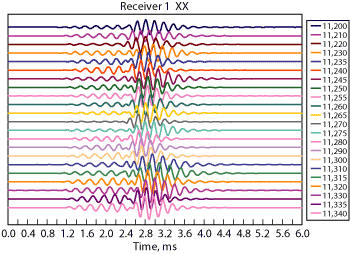 |
|
Fig. 1. Array cross-dipole seismogram for the fractured dolomitic limestone; component XX of Receiver 1 at all depths.
|
|
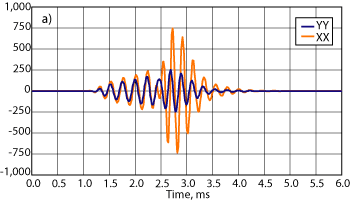
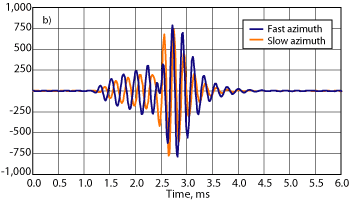 |
|
Fig. 2. a) Comparison of waveforms of the XX and YY components. Receiver 1 is at the depth of 11,300 ft of the dolomitic limestone, where the slow shear azimuth is 23°. b) Comparison of waveforms at the fast and slow shear azimuths for Receiver 1.
|
|
INVERSION METHOD AND RESULTS
We applied a new method for the inversion of parameters of fast shear-wave slowness (s1), slow shear-wave slowness (s2) and slow shear-wave azimuth (u) from cross-dipole logs. We followed the basic principles of Tang and Chunduru’s approach,4 and transformed the three-dimensional object function into three new, one-dimensional object functions under the same anisotropic condition while keeping the redundancy of information of the original object function. The tranform is facilitated through a change of variable and subsequent mathematical treatment. The inversion was carried out through minimization of three individual one-dimensional object functions instead of global minimization of one three-dimensional object function. The coupled unknown s1, s2 and u were extracted separately and more efficiently. No first guesses of them were needed. The algorithm has been validated by abundant synthetic data. A description of the algorithm will be presented in the international meeting of the Society of Professional Well Log Analysts (SPWLA) in The Woodlands, Texas, in June 2009.
We applied the inversion algorithm to the cross-dipole waveform data for the limestone and shale models. The inversion results are given in Figs. 3 and 4. It was observed that the inverted u matched the exact synthetic model data perfectly at all depths regardless of type of the formation, degree of anisotropy or value of u. The agreement between the inverted and exact values was also very good for both s1 and s2. It currently takes about one hour to complete the inversion of cross-dipole data at about 20 depths of a formation on a Pentium M laptop with a 2.26 GHz processor. There is room for improvement in both accuracy and efficiency.
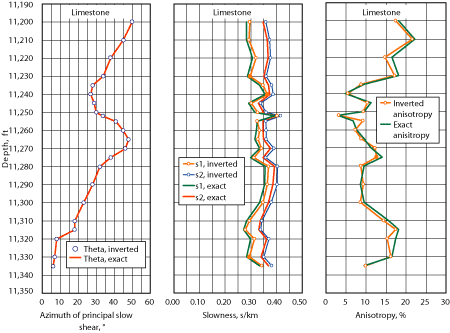 |
|
Fig. 3. Inversion results compared with input model parameters of the fractured dolomitic limestone.
|
|
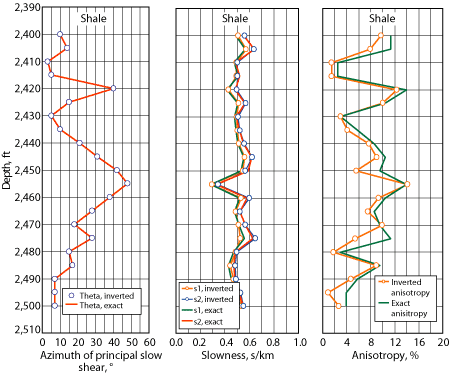 |
|
Fig. 4. Inversion results compared with input model parameters of the fractured shale model.
|
|
EXTENSION OF THE ALGORITHM TO DEVIATED WELLS
We are currently extending the above algorithm to invert cross-dipole sonic logs acquired in deviated wells. For inverting sonic logs in deviated wells, Hornby et al. inverted Thomsen parameters d, ´ and vertical P-wave velocity in shale from P-wave sonic logs acquired in multiple boreholes with known deviation angles.5 Vernik corrects P- and SH-wave velocities using dipole sonic logs from deviated wells under the condition that the effective Thomsen parameters d, ´ and g are predetermined from shale content in siliciclastic rocks.6
However, no work on inversion of intrinsic shear-slowness solely from cross-dipole data has been reported. In our approach, to invert intrinsic shear-slowness from cross-dipole data recorded in deviated wells intercepting transversely isotropic formations, we required data from at least two known, distinct deviation angles. We have extended the TBIE method to dipping wells7 to generate synthetic data for testing the extended algorithm.
CONCLUSIONS
Based on existing borehole-array processing algorithms, we have developed a new method for inverting cross-dipole sonic waveforms. The inversion algorithm, based on the new object functions, successfully separates and extracts the unknown u, s1 and s2 from synthetically generated array cross-dipole logs. The processing is fast and reliable. We have verified the inversion result using a large amount of reliable synthetic waveform data for vertical boreholes. The agreement between the inverted and input values is very good. The software will be applied to process real cross-dipole data acquired in vertical wells. The algorithm is being extended to process cross-dipole data acquired in deviated wells.
ACKNOWLEDGEMENTS
This work was supported by the Southwest Research Institute Research Program, project No. 14-9700.
LITERATURE CITED
1 Xu, P.-C. and J. O. Parra, “Effects of single vertical fluid-filled fractures on full waveform dipole sonic logs,” Geophysics, 68, No. 2, 2003, pp. 487−496.
2 Parra, J. O. and H. A. Collier, “Characterization of fractured zones in the Twin Creek Reservoir, Logepole Field, Utah-Wyoming overthrust belt,” Petrophysics, 49, No. 5, 2000, pp. 351−362.
3 Parra, J. O., Hackert, C. L., Xu, P.-C. and H. A. Collier, “Attenuation analysis of acoustic waveforms in a borehole intercepted by a sand-shale sequence reservoir,” The Leading Edge, 25, No. 3, 2006, pp. 186−193.
4 Tang, X. M. and R. K. Chunduru, “Simultaneous inversion of formation shear-wave anisotropy parameters from cross-dipole acoustic-array waveform data,” Geophysics, 64, No. 5, 1999, pp. 1502–1511.
5 Hornby, B. E., Howied, J. M. and D. W. Ince, “Anisotropy correction for deviatred-well sonic logs: Application to seismic well tie,” Geophysics, 68, No. 2, 2003, pp. 464−471.
6 Vernik, L., “Anisotropic correction of sonic logs in wells with large relative dip, Geophysics, 73, No. 1, 2008, pp. E1−E5.
7Xu, P.-C. and J. O. Parra, “Synthetic multipole sonic logs and normal modes for a deviated borehole in anisotropic formations,” 77th Annual International Meeting, Society of Exploration Geophysicists, Expanded Abstracts, 2007, pp. 353−357.
|
THE AUTHORS
|
| |
Jorge O. Parra is the Institute Scientist at Southwest Research Institute. He has PhD and MS degrees in geophysics from the Colorado School of Mines, as well as a mining civil engineering degree from the University of Chile. He has contributed to advances in electromagnetic, resistivity, borehole geophysics, poroelasticity and anisotropy, and seismic modeling/interpretation. Dr. Parra has more than 100 publications and four patents. He is a member of SEG and SPWLA and an editorial member of the Journal of Applied Geophysics. He received Best Poster Presentation Award for the SEG 2001 and SPWLA 2002 conferences.
|
|
| |
Dawn Domaschk is a Research Engineer at Southwest Research Institute, where she specializes in signal and image processing and embedded systems design. Ms. Domaschk earned a BSc in electrical engineering and a BBA in engineering route to business from the University of Texas at Austin.
|
|
| |
Pei-cheng Xu is a Research Scientist at Datatrends Research Corp., Canada. He has PhD and MS degrees in engineering from the University of California, Los Angeles, as well as a BSc degree in applied mechanics from Tongji University of China. He has contributed to borehole geophysics, wave propagation in stratified, fractured, poroelastic and anisotropic media, seismic/sonic data modeling/interpretation/inversion, and ultrasonic nondestructive testing. He has more than 40 publications and two patents. He is a member of SEG and ASA. He received the Best Poster Presentation Award for the SEG 2001 conference.
|
|
| |
|







